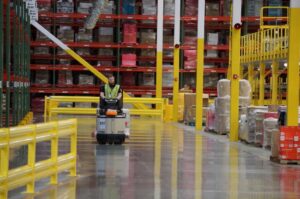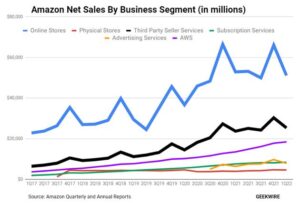APRIL 28, 2022

Inside an Amazon fulfillment center in Washington state. (GeekWire File Photo)
Amazon added warehouse space faster than it ultimately needed in response to the challenges of the pandemic, outpacing consumer sales and resulting in an extra $2 billion in costs in the first quarter.
However, given the extraordinary demand and uncertainty Amazon was seeing at the time, there’s not much else the company could have done, even in hindsight, said Brian Olsavsky, Amazon’s chief financial officer, on calls with reporters and analysts Thursday following the company’s quarterly earnings report.
The costs contributed to a quarter that fell well short of Wall Street’s expectations, sending Amazon’s shares down more than 10% in after-hours trading Thursday.
“We’ve come out of a very tumultuous two years,” Olsavsky told analysts. “We are glad we made the decisions we made over the past two years. And now we have a chance to right-size our capacity to a more normalized demand pattern.”
Amazon’s online sales fell 3% for the quarter to $51 billion, as shoppers relied less on the company for critical purchases, with the decline of the Omicron variant of COVID-19 signaling a turning point in the pandemic.

However, Olsavsky said the company expects sales growth to ultimately catch up with the capacity the company has added. Amazon plans to slow the pace of its warehouse expansions in the meantime.
Amazon’s recent announcement of a “Buy with Prime” program, serving e-commerce sites other than Amazon.com, was widely seen as sign of the company using more of its fulfillment and delivery capacity to offering shipping as a service — generating additional revenue in competition with UPS and FedEx.
The company’s investments in recent years have included creating its own delivery network, known as “AMZL,” leveraging a network of dedicated Amazon Delivery Service Partners and reducing its dependence on third-party delivery companies such as UPS and the U.S. Postal Service.
In the company’s earnings release today, Amazon CEO Andy Jassy said the year-over-year growth of 39% that Amazon saw in its consumer business during the pandemic in 2020 “necessitated doubling the size of our fulfillment network that we’d built over Amazon’s first 25 years — and doing so in just 24 months.”
Amazon’s fulfillment network and data center facilities (owned and leased, domestic and international) rose from 272 million square feet at the end of 2019 to 525 million square feet at the end of 2021, according to its annual SEC filings. The filings do not break out the fulfillment square footage separate from data centers.
RELATED STORY
Amazon stock sinks 10% after Q1 earnings as costs rise amid inflation, supply chain pressure
A big part of the challenge, Olsavsky explained, is that decisions for adding new facilities need to be made years in advance. They can’t be put on hold when the company has a better sense for demand.
“We literally committed to as much as we could to handle the volume that we saw,” Olsavsky told reporters. “We did not want space to be constrained. Even with that intent, it took until the second quarter of last year for us to feel like we had enough space. And then we continued to add warehouses for the peak last year in Q4.”
Olsavsky said the capacity will start to better match demand with Prime Day in the third quarter of this year, followed by the peak holiday shopping season in the fourth quarter.
Courtesy/Source: Geekwire

































































































